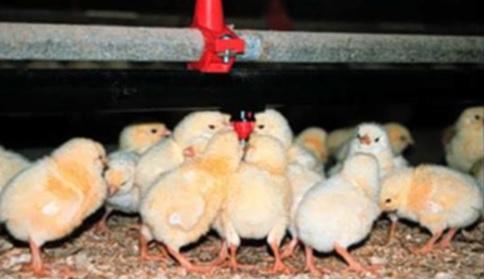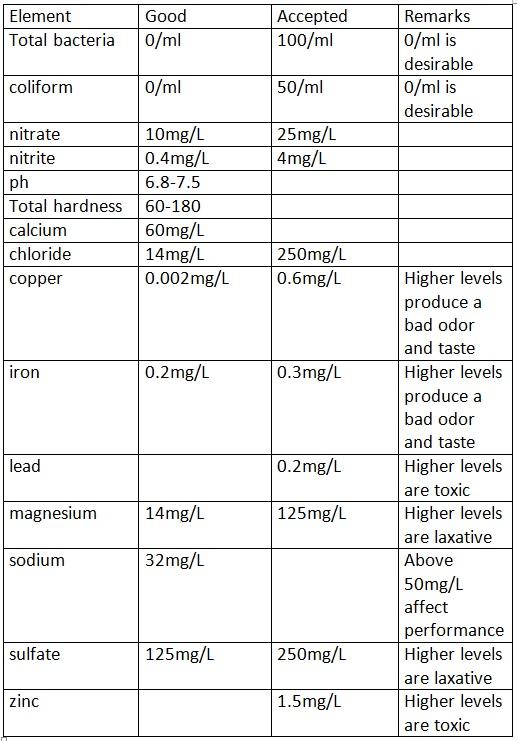Water in Poultry Farms
Published: September 4, 2018
By: Khaled Fadlallah Mohammed / Veterinary Doctor, Cairo, Egypt.
Water is life and there is no life without it. Similarly, poultry has no life without water. It represents 85% of the weight of the chick, 75% of the weight of the egg and 65% of the weight of the chicken. And the chicken drinks more than double the amount of feed it eats and if the amount of water provided to poultry decreases, the production of eggs decreases directly and stops completely if the water is prevented for two days. In addition, the bird begins to dry and vitality and health are affected as a result of increased inflammation of the kidneys. This is as a result of the increased rate of deposition of salts in both kidneys and that leads to increased mortality rates in chicks.
Water is the most important nutrient for poultry; survival time of the bird is limited to water absence. Birds can survive for long periods without any other nutrient in its feed but they cannot survive without water. Water quality attributes can have a direct or indirect effect on performance. High levels of bacterial contamination, high levels of minerals, or other pollutants in drinking water can have detrimental effects on normal physiological properties resulting in decreased performance. Water quality can be evaluated by a number of criteria. It can be difficult, however, to describe good quality drinking water for poultry because many of the standards have been derived from recommendations for other species of animals or from human standards. In many cases, the guidelines of water quality have been established based on mortality and not decrease in performance. Submitting a water sample annually for analysis should be an important part of good water management. The results of the analysis should be interpreted appropriately to determine the proper course of action.
Safe water supply is essential for healthy poultry. Contaminated water can affect growth, reproduction, and productivity of poultry as well as the safety of poultry products for human consumption.
Poultry can also contaminate human drinking water. For these reasons, farm water supplies should be protected against contamination from bacteria nitrates, sulfates, and pesticides.

Water assessment is very important to the poultry growers as it has to be a priority to prepare the breeding houses and should not ignore them from the chemical specifications of dissolved salts as well as the level of bacterial and fungal contamination. Drinking water can cause many disease problems.

Water quality guidelines for poultry are hard to find. Thus, many values have been obtained from human and other livestock guidelines. Factors such as bacteria, pH level, hardness or total dissolved solids, nitrate levels and high naturally occurring elements can affect water quality. These, in turn, can affect poultry health and performance.
Water sources should be checked annually for bacterial and mineral content. Wells can be contaminated by surface water, and thus should be tested after a heavy rainfall. The results of water analysis can be affected if the sample is taken incorrectly. Interpretation of water analysis should be conducted by an experienced person in order for the correct course of action to be taken.

Water is also a very important element and it can negatively affect some antibiotics and most antiseptics. All vaccinations are affected by varying degrees of water quality, soluble salts, pH and alkalinity. It has been agreed that vaccination doses in drinking water will be 1.5 doses to prevent the exposure of vaccines to be partially damaged. Some elements such as iron in drinking water severely affect all vaccines and must not exceed 1 mg / l
The presence of varying levels of nitrite and nitrates may lead to cases of poisoning of blood and is often produced with the use of well water from the places which uses agricultural fertilizers. It is necessary to pay attention to the pipes of raising the water from the wells and maintaining them so as not to pass bacteria to the water used in drinking, and taking into account that the places of disposal of the deceased and toilets away from water sources.
Calcium salts (Calcium, Magnesium and Carbons) significantly affect growth, at rates higher than 700 mg / L, affecting the kidneys and leading to the formation of calcareous deposits. The salts of hardness affect very much the equipment, especially the cooling sheets and reduces the life of this sheets. The immune system of the bird is negatively affected with the use of poor quality of water, where the chloride salts cause incidence of intestinal infections and chronic diarrhea, as well as kidney failure and problems in digestion and imbalance in the acidity of blood.

Drinking water problems
Microbial contamination
Water wells are usually contaminated by sewage and thus cause pathogenic microbes to enter the bird's body. Water is the most important source of infection in poultry and the most microbial diseases affecting poultry through drinking water such as salmonella,E. coli, cholera and coccidiosis. Poultry cannot be treated for diarrhea or other diseases until water has been treated as a primary source of infection.
High counts may also result from poor well construction (particularly in the case of old or shallow wells) or poor maintenance if the well is not properly protected from surface drainage water.
It is not advisable to increase the use of disinfectants to maintain a safe bacterial count in a highly contaminated well. Any disinfectant method may fail at some time and expose the poultry to high levels of bacteria. The best method is to eliminate the source of contamination. If that is not feasible, constructing a new well may be the best alternative.
If the water source has a low bacterial count, poultry may be exposed to the microorganisms that grow in waterers. Because these organisms can develop rapidly, so waterers should be cleaned properly each day. Chlorination or use of other disinfectants in the water along with good waterer cleaning is an effective way of controlling microbial levels.
Chlorination using a device for accurately injecting the correct proportion of chlorine into the water line has been successful in poultry operations if the residual chlorine level in the waterers is at least 1 milligram per liter. Once the water is exposed to the air the dissolved chlorine quickly dissipates. To accurately determine the residual chlorine level in the water that the poultry drink, the chlorine concentration should be measured using a standard test as soon as possible after samples are obtained from the waterers. Superchlorination or continuous treatment of the well with chlorine can also be effective, but the level of chlorine in the drinking water must be controlled because excess chlorine will decrease poultry water consumption.
Use of an iodine-based disinfectant to control bacterial contamination in drinking water is effective but is usually more expensive than chlorination. Use only approved chemicals at the recommended rates and ensure that the chemicals are compatible with watering equipment. Remove the disinfectant from the waterers and water lines before using a water vaccine or medication that is incompatible with the disinfectant.
Chemical pollution
An increase in the proportions of salts and minerals lead to the following problems:
- Sediments and blockages in waterways, trenches and waterways.
- Corruption of used vaccines.
- Drug corruption and deposition in water.
The following effects were observed in poultry as a result of increased salts:
- Increasing the proportion of calcium salts in water impede the absorption of nutrients in feed and also impede the absorption of antibiotics.
- Increasing the proportion of magnesium salts in water may lead to water diarrhea with impaired digestion and absorption.
- Increasing the percentage of iron salts leads to the presence of pigments in poultry meat and eggs.
- The increase of sulfur salts leads to bleeding (the occurrence of bleeding) and edema in poultry.
Water Health
The health of drinking water is a vital element for the success of poultry projects. Water, as well as being a staple food component, is the primary medium through which medicines and vaccines are given to poultry. On the other hand, it represents one of the most important sources of disease transmission if it is contaminated with viral, bacterial, fungal and parasitic microbes ... etc
Therefore, sterilization of drinking water for poultry with chlorine is the cheapest and most suitable for the drinking water of poultry regularly, taking into consideration the period of immunization and vaccinations, which stops the addition of chlorine before and after the vaccine by 24 hours.
For this reason, the drinking water supplied to poultry must have the following sanitary conditions:
First, be fresh and clean free from impurities and odors that indicate that the water it is not contaminated with microbes or toxic chemicals
Second, the palatable water offers a somewhat cool taste in the summer, and is warm enough in the winter, so that the birds can consume sufficient amounts to perform the functions of their physiological functions.
Third, the water is provided in sufficient quantities, while ensuring that its sources are distributed in the poultry house in a regular manner, so that all the birds can get it as much as necessary. The quantity of water should be commensurate with the amount of the feed eaten by the bird and by 2 water: 1 Feed
It is worth mentioning that water contributes to the performance of many physiological functions and vital for poultry:
1- Water is necessary for the body processes as digestion and absorption and then execration.
2- The bird's body can not regulate its temperature and maintain its stability without water.
3- Water plays a key role in the process of dissolving all nutrients and from here it is transmitted to all parts of the body, to carry out its vital functions.
The following table shows the specifications of drinking water for poultry.

Related topics:
Authors:
Recommend
Comment
Share

Would you like to discuss another topic? Create a new post to engage with experts in the community.











